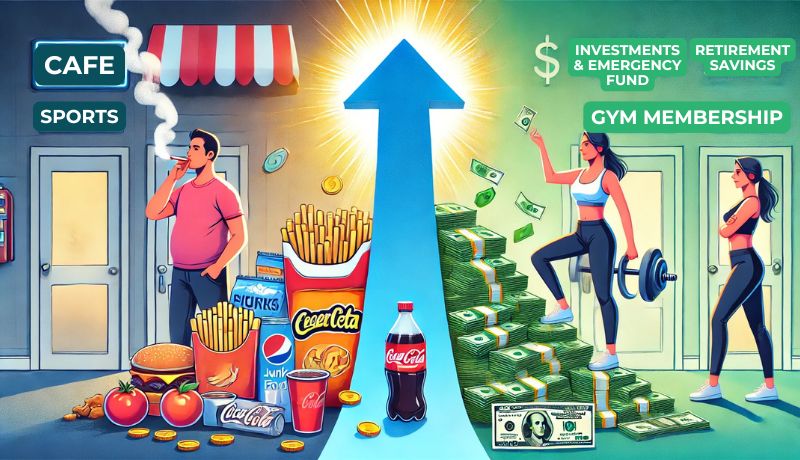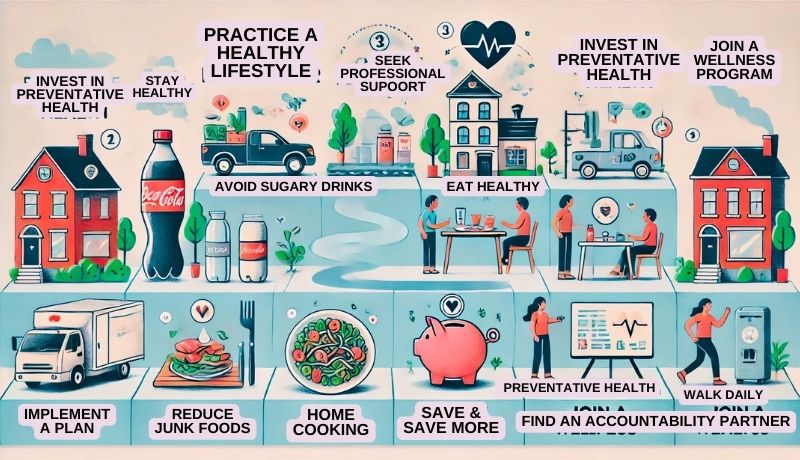
Have you ever stopped to think about how much your daily habits affect not just your health but also your wallet? Many people associate unhealthy lifestyle choices with physical consequences, like weight gain, fatigue, or increased risk of disease.
But what about the financial toll?
Unhealthy habits—such as smoking, excessive drinking, poor diet, and a sedentary lifestyle—don’t just chip away at your well-being; they also drain your hard-earned money in ways you may not even realize. The cost isn’t just about medical bills.
These habits can impact your productivity, raise your insurance premiums, and even limit your long-term financial growth.
The True Cost of Unhealthy Habits
According to the Centers for Disease Control and Prevention (CDC), chronic diseases account for a staggering 90% of the nation’s $4.1 trillion annual healthcare expenditure. That’s an eye-opening number, and much of it stems from preventable conditions caused by lifestyle choices.
But here’s the good news: reversing these habits not only improves your health but also boosts your financial future.
In this article, we’ll break down the hidden financial burden of unhealthy habits and provide practical ways to turn things around.
The Hidden Financial Costs of Unhealthy Habits
1. Medical Expenses: The Price of Poor Health
Chronic diseases such as diabetes, heart disease, and obesity-related conditions often stem from lifestyle choices. These illnesses require frequent doctor visits, medications, and sometimes even hospitalizations—all of which come with a hefty price tag.
📌 The Real Cost:
- Treating Type 2 diabetes can cost thousands annually in medication, doctor visits, and lifestyle management.
- The American Diabetes Association estimates that people with diabetes have healthcare costs approximately 2.3 times higher than those without the condition.
📌 How to Save:
- Investing in preventative health—such as regular exercise and a balanced diet—can significantly reduce medical costs in the long run.
- Routine checkups and early interventions help catch potential health issues before they become expensive problems.
✅ Fun Fact: Did you know that for every $1 spent on preventive health measures, $5.60 is saved in future medical costs? Small changes today can lead to major savings down the road!
💡 Pro Tip: Some employers and health insurance providers offer wellness incentives, such as reimbursements for gym memberships or discounts on premiums for completing health assessments—check to see if you’re eligible!
2. Lost Productivity and Earnings

Your health plays a huge role in how well you perform at work. Poor health leads to absenteeism, reduced work efficiency, and in severe cases, early retirement due to illness. That’s lost income potential!
📌 The Real Cost:
- A study by the Integrated Benefits Institute found that poor health costs U.S. employers a whopping $530 billion annually due to lost productivity.
- Individuals who frequently take sick days or struggle with low energy levels are less likely to receive promotions and salary increases.
📌 How to Save:
- Prioritizing fitness and nutrition boosts energy levels, focus, and overall job performance.
- A healthier lifestyle can lead to fewer sick days, increased efficiency, and better career growth.
✅ Trivia: A study found that employees who exercise at least three times a week earn 9% more on average than their sedentary peers! Staying active can literally pay off.
💡 Pro Tip: If you have a desk job, try the 20-20-20 rule—every 20 minutes, look at something 20 feet away for 20 seconds to reduce eye strain and boost focus.
3. Increased Insurance Premiums
Think your life or health insurance premiums are high? If you engage in unhealthy behaviors, they’re likely even higher than they need to be.
📌 The Real Cost:
- Smokers pay up to 50% more for life insurance compared to non-smokers.
- Being overweight or having chronic health issues can increase life insurance premiums by up to 25%.
📌 How to Save:
- Quitting smoking, maintaining a healthy weight, and adopting an active lifestyle can lower your insurance premiums and save thousands over a lifetime.
- Some insurance companies offer discounts for healthy behaviors—take advantage of them!
✅ Fun Fact: Many life insurance companies now offer wearable fitness tracker discounts, where hitting daily step goals or maintaining a healthy heart rate can earn you premium reductions.
💡 Pro Tip: If you’ve recently made positive lifestyle changes—like quitting smoking or losing weight—ask your insurance provider for a policy reassessment. You might qualify for lower rates!
4. The Opportunity Cost of Unhealthy Spending
You might not realize how much money is slipping away due to unhealthy spending habits. Whether it’s smoking, junk food, or excessive alcohol, these costs add up quickly.
📌 The Real Cost:
- A daily $5 coffee and pastry habit adds up to over $1,800 per year—money that could be invested.
- A pack-a-day smoking habit costs approximately $2,500 annually.
- Fast food meals a few times a week can easily amount to $3,000 or more per year.
📌 How to Save:
- Redirect spending toward healthier alternatives like home-cooked meals, fitness memberships, or savings and investments.
- Cutting back on just one unhealthy habit could free up extra cash for an emergency fund, vacation, or retirement savings.
✅ Trivia: The average American spends $1,200 per year on fast food—that’s enough to buy a home gym setup or invest in a stock portfolio!
💡 Pro Tip: Use the “health tax” strategy—for every dollar spent on unhealthy habits (junk food, smoking, etc.), match that amount into a savings or investment account. You’ll quickly see how much money is wasted on unhealthy choices.
The Emotional and Social Costs of Poor Health Choices

Money aside, unhealthy habits also take a toll on your emotional well-being and relationships. When you don’t feel your best, it affects every aspect of your life.
📌 The Real Cost:
- Sleep deprivation is linked to increased irritability, poor cognitive function, and even depression.
- Chronic stress and inactivity can lower motivation, making it harder to break negative cycles.
- Struggling with poor health can lead to strained relationships due to mood swings, fatigue, and lack of participation in social activities.
📌 How to Save:
- Establishing healthier routines improves mental well-being and strengthens relationships by increasing energy and engagement in social activities.
- Exercise, meditation, and proper sleep habits can work wonders for both your emotional and social life.
✅ Fun Fact: Studies show that just 20 minutes of walking per day can reduce symptoms of depression and anxiety by up to 30%! Movement isn’t just for your body—it’s great for your mind too.
💡 Pro Tip: If you struggle with stress eating or emotional exhaustion, try habit stacking—pairing a new, healthy habit with an existing one.
For example, meditate for 2 minutes while your morning coffee brews or do a few stretches while watching TV.
How to Reverse Unhealthy Habits and Build Wealth
If you’re feeling overwhelmed, don’t worry! You don’t have to overhaul your entire lifestyle overnight. Small, intentional changes can make a significant impact over time.
Here’s how to start:
1. Identify and Understand Your Triggers
- Recognize the environmental, emotional, or situational cues that lead to unhealthy behaviors.
- Understanding your triggers helps you develop strategies to avoid or manage them effectively.
2. Replace Unhealthy Habits with Positive Alternatives
- Instead of simply trying to eliminate bad habits, swap them with healthier behaviors that satisfy the same need.
- For example, if stress leads to overeating, try physical activity or mindfulness techniques instead.
3. Implement ‘If-Then’ Planning
- Create action plans for handling triggers: “If I feel the urge to smoke during a break, then I will take a five-minute walk instead.”
- This strategy helps automate healthier responses and reinforces good habits.
4. Start Small and Make Gradual Changes
Big changes can feel intimidating, so focus on one small habit at a time.
- Swap soda for water.
- Take a 10-minute walk daily.
- Cook at home more often.
5. Create a Budget for Healthier Choices
Reallocate spending from unhealthy habits to better alternatives:
- Invest in meal prepping to save money and eat healthier.
- Use a portion of what you save from quitting smoking or fast food to join a gym or buy fresh produce.
6. Leverage Financial Incentives
- Allocate savings from quitting smoking or reducing junk food toward investments or emergency funds.
- Take advantage of health insurance discounts and employer wellness programs.
- Reward yourself financially for reaching health goals (e.g., put $10 into savings every time you complete a workout).
7. Find an Accountability Partner
Having support makes all the difference!
- Join a fitness group or find a workout buddy.
- Consider participating in a financial or health challenge to stay motivated.
8. Invest in Preventative Health
Think of health as a long-term investment rather than an expense.
- Regular exercise, nutritious eating, and mental well-being will save you money in medical bills down the road.
- Long-term benefits include increased energy, reduced stress, and better financial stability.
9. Seek Professional Support
- Consider consulting healthcare professionals or counselors who can provide personalized guidance.
- Professional accountability can increase the likelihood of successfully breaking unhealthy habits.
Conclusion
Unhealthy habits do more than affect your waistline—they have serious financial, emotional, and social consequences. But the good news? You have the power to change.
By making small, intentional changes today, you can improve your well-being while securing your financial future. The sooner you start, the more you’ll save—in both health and wealth.
So, are you ready to take charge of your health and finances? Let’s make the shift today! 🚀



This article really made me rethink the true cost of our daily habits not just in terms of health but also financially. It shows that unhealthy choices like smoking, poor diet, and inactivity can lead to expensive chronic diseases, lost productivity, higher insurance premiums, and even missed opportunities for savings.
I especially appreciated the practical tips on reversing these habits, like starting small, using if-then planning, and reallocating spending towards healthier choices.
Has anyone here successfully made a change that improved both their health and financial situation? I’m curious to hear your experiences and any additional tips you might have!
Hi Dan,
Thank you for your thoughtful comment!
I’m so glad the article resonated with you and got you thinking about the broader impact of daily habits. It’s true—our choices don’t just affect our health; they also shape our financial future in ways we often don’t consider until the costs start adding up.
I love your question! Many people have seen incredible benefits from even small lifestyle changes. For example, someone who switches from takeout lunches to home-cooked meals might not only improve their nutrition but also save hundreds of dollars a month. Or someone who replaces their smoking habit with a fitness routine might see long-term health benefits while avoiding the rising costs of cigarettes and medical bills.
Have you made any changes yourself that had a noticeable impact on both your health and finances? I’d love to hear your thoughts, and hopefully, others will share their experiences too!